Eiffel Tower
The Eiffel Tower (French Tour Eiffel, [![]()
![]() tuʁ‿ɛˈfɛl]) is a 324-metre-high iron truss tower in Paris. It stands in the 7th arrondissement at the northwestern end of the Champ de Mars (Field of Mars), near the banks of the Seine. Built from 1887 to 1889, the structure was erected as a monumental entrance and observation tower for the World's Fair to commemorate the 100th anniversary of the French Revolution. Named after its builder Gustave Eiffel, the tower, which was 312 metres tall at the time of construction, was the tallest structure in the world from its construction until the completion of the Chrysler Building in New York in 1930. The structure contributed to the history of radio and television as a broadcasting tower with the broadcasting of the first public radio program in Europe in 1921 and the first French television program in 1935. The television tower is the most important broadcasting facility in the greater Paris area and houses the Michelin-starred restaurant Le Jules Verne as a tower restaurant.
tuʁ‿ɛˈfɛl]) is a 324-metre-high iron truss tower in Paris. It stands in the 7th arrondissement at the northwestern end of the Champ de Mars (Field of Mars), near the banks of the Seine. Built from 1887 to 1889, the structure was erected as a monumental entrance and observation tower for the World's Fair to commemorate the 100th anniversary of the French Revolution. Named after its builder Gustave Eiffel, the tower, which was 312 metres tall at the time of construction, was the tallest structure in the world from its construction until the completion of the Chrysler Building in New York in 1930. The structure contributed to the history of radio and television as a broadcasting tower with the broadcasting of the first public radio program in Europe in 1921 and the first French television program in 1935. The television tower is the most important broadcasting facility in the greater Paris area and houses the Michelin-starred restaurant Le Jules Verne as a tower restaurant.
As the tallest building in Paris, it still dominates the cityscape today and is one of the most visited landmarks in the world, attracting around seven million paying visitors a year. The tower is one of the most famous icons of architecture and engineering. The Eiffel Tower is the model for many imitation buildings and is often referred to in art and culture in connection with Paris and France. It is considered a national symbol of the French and has become a worldwide icon of modernism. Since 1964, the Eiffel Tower has been listed as a monument historique, and in 1986 the American Society of Civil Engineers included the structure in its list of historic milestones of engineering.
Description
Location and surroundings
The Eiffel Tower is located in the west of the 7th arrondissement of downtown Paris at the northwest end of the Champ de Mars. It stands at 33 meters above sea level not far from the banks of the Seine, where there are also landing stages for excursion boats. Not far from it, southwest of the Eiffel Tower, is the elongated Île aux Cygnes (Swan Island) in the Seine. In the immediate line of sight of the structure is the École Militaire to the southeast and the Palais de Chaillot to the northwest on the opposite bank of the river above the Pont d'Iéna, widened to 35 meters in 1937. To the southeast of the École Militaire is the UNESCO headquarters in a Y-shaped building built in 1958. About three kilometers away as the crow flies in a southeasterly direction, slightly north of the exact line of sight, is the 210-meter-high Tour Montparnasse office tower. To the northeast, near the Eiffel Tower, is the Musée du quai Branly ethnological museum.
The following roads open to vehicular traffic are tangential to the tower site: to the southwest, Avenue Gustave Eiffel; to the northeast, Avenue de la Bourdonnais; to the northwest, the busy Quai Branly, from which the Pont d'Iéna branches off across the Seine; and to the southeast, Avenue de Suffren. The four streets border a wooded, park-like rectangular plot of land centered on the Eiffel Tower. Motorized traffic is not allowed to pass through.
The closest Métro Paris stops to the Eiffel Tower are Bir-Hakeim (Tour Eiffel) on line 6 and École Militaire on line 8. Line C of the Paris RER commuter rail system stops southwest of the tower at Champ de Mars - Tour Eiffel station. Several bus lines stop in the immediate vicinity of the Eiffel Tower.
Architecture
Detailed views
As Gustave Eiffel explained in a lecture to the Société des Ingénieurs civils on 30 March 1885, the architecture of the tower was about,
"to dispense with the large lattice bars of the vertical surfaces, which were to resist the wind. Therefore, the pier is to be given a shape such that all the forces for which the wind is responsible concentrated on the inside of the supporting uprights. [...] The tangents located at points of equal height to these supports must always meet at the point of passage of the resultant of the load exerted by the wind on the part of the pier above the points in question. [...] Before the supports unite at this high point, they seem to shoot up out of the ground, and receive their shape, as it were, by the action of the wind."
As sophisticated as the architecture is for optimizing the wind load, the basic concept of the Eiffel Tower, which has the large railway bridges made of iron trusses as its structural model, is comparatively simple. Sixteen vertically offset main struts, grouped in groups of four, rise up in an arc and are connected by the three horizontal visitor platforms. Above the second platform, the struts are united to form a pylon.
Tower base and foundation
The Eiffel Tower stands at a height of 30.5 meters above sea level at the northwestern end of the Champ de Mars (→ location). The building stands on four mighty supporting pillars made of iron trusses, each 26.08 meters wide; they transfer the entire weight to the foundation, which extends to a depth of 15 meters. The piers rest on solid masonry and are anchored to the ground with 16 rafters at a 54-degree angle. Screws 7.80 meters long connect the cast iron shoe with the substructure.
The tower construction is supported by the substructure in such a way that, depending on the wind load, it transmits a pressure of about 5 kg/cm² to the ground. This is roughly equivalent to the ground pressure exerted by an adult sitting on a chair - a comparison that Eiffel himself calculated and stated in his publication La Tour de 300 mètres.
The piers are 74.24 meters apart at the bottom, which corresponds to a total spread of the tower at the base of 124.90 meters. The floor plan of the base is square. The Eiffel Tower was constructed in such a way that each of its pillars is aligned exactly with one cardinal direction. The north and west pillars face the Seine, while the east and south pillars face the Champ de Mars. Each of the pillars contains entrances with ticket booths, staircases and elevators, which may be open in different ways depending on the crowds and the occasion. The distance between the pillars, which are connected by mighty arches, decreases with increasing height. The arches, also made of filigree-looking iron latticework, 39 metres above the ground and with a diameter of 74 metres, are purely decorative and have no load-bearing function. The passage between the pillar feet is exclusively reserved for pedestrians. On the north pillar there is a gold-coloured bust on an elongated pedestal in honour of the builder Gustave Eiffel.
Southwest of the west pier, a red brick chimney overgrown with shrubs juts out from an artificial grotto. It dates from 1887 and was used to construct the south pier during the construction phase. As part of the redesigned enclosure of the Eiffel Tower in 2018, the entire area below the piers and partially beyond was landscaped into a new garden. The area contains plants and trees, some of which predate the construction of the Eiffel Tower. Among the oldest trees is a 20-metre-high plane tree planted in 1814. The green area of approximately 2000 hectares with about 2000 shrubs and 20,000 perennial plants, such as ferns, lily of the valley or hydrangeas were newly planted to give the visitor an impression of the turn of the 20th century, which had many Parisian gardens at the time of the Belle Epoque.
· 
Tower base
· 
Entrance at the east pillar
· 
Eiffel's bust on the north pillar
First floor
The first floor above the arches at a height of 57.6 metres offers space for around 3000 visitors at a time on a usable area of 4415 square metres. The restaurant 58 Tour Eiffel, a self-service restaurant and the cinema hall Cineiffel, which can also be used as an exhibition space, are located on this level. The wrap-around balcony on this level has panoramic panels on the parapet to help locate the Parisian landmarks visible from there. There is a souvenir shop and, in the south pillar, a small post office (Bureau de Poste Tour Eiffel) open daily and carrying its own postmark as a souvenir receipt. On the first floor, the 300-square-metre Gustave Eiffel Hall, which can be rented, is ideal for meetings, conferences, concerts or receptions.
At the beginning, the Eiffel Tower had elaborately glazed halls on its first floor, which were conspicuous from the outside by their arched roof structures. They contained, among other things, four restaurants with different themes. Between the north and east pillars was the Russian restaurant, now called the Gustave Eiffel Room. Between the south and west pillars was the Anglo-American bar, between the east and south pillars was the French restaurant, and between the north and west pillars was the Flemish restaurant. The latter was converted into a Dutch restaurant after the 1889 Exposition and was used as a theatre hall after 1900. All of these buildings and the historic ornaments were demolished in the course of the 1937 World's Fair and replaced by ones that were less conspicuous from the outside, in order to adapt them to the changed taste.
Along a frieze on the first floor are 72 names of eminent scientists and technicians, 18 on each side. When the tower was repainted at the beginning of the 20th century, the names disappeared; in 1986 and 1987 they were made visible again. They are mainly engineers and mathematicians who worked during the French Revolution and the first half of the 19th century. Eiffel himself made the selection of names; he was criticized for some of them. He deliberately omitted scientists with long surnames and also women who rendered outstanding services to science, for example also the important French mathematician Sophie Germain.
Second floor
At a height of 115.7 metres is the second floor with an area of 1430 square metres, which offers space for around 1600 visitors at a time. The second floor can be reached either by elevator or by one of the staircases located in the pillars; 704 steps lead up from the base to the second floor. At this level, the transfer to the elevators takes place, which continue to the top.
Here you will find the Jules Verne restaurant with 95 seats. It offers upscale gastronomy, was awarded one star by the Guide Michelin and received 16 out of a possible 20 points from Gault-Millau. The restaurant, with a floor area of 500 square metres, is slightly elevated on the south pillar at a height of 123 metres and is accessible via a separate lift. It has been under the management of chef Alain Ducasse since 2007.
There is also a snack bar and a souvenir shop on this level. The history of the Eiffel Tower is told in words and pictures in showcases specially set up for visitors.
Third floor and spire
The third and top platform is located at a height of 276.1 meters and has an area of 250 square meters. This floor is accessible to the public only via the elevators. However, there is a continuous staircase that has 1665 steps starting in the east pillar to the top. It replaced the original staircase of 1710 steps in 1983 and is lighter and less dangerous. To date (2020), the top observation deck is the fourth highest publicly accessible in Europe; the highest observation deck is currently at Oko Tower 1 in Moscow.
Above the covered platform, stairs lead up to the open-air platform, which is secured by steel grids and measures around 100 square metres. The entire area of the third floor can accommodate up to 400 people at a time. In good weather, you can see up to 80 kilometres from here. Panels point to major cities in the world in the corresponding cardinal direction and indicate the distance as the crow flies from the Eiffel Tower. In addition to a champagne bar, Eiffel's study has been faithfully restored and furnished with wax figures showing Eiffel, his daughter Claire and the American inventor Thomas Edison trying out the phonograph that Edison had brought for Eiffel as a present for the opening of the tower.
Above the visitor platform at a height of 295 meters, there is a beacon for each cardinal direction. The movement is controlled by software and can be synchronized in such a way that a continuously rotating cross is simulated with the beacons. At this height there are also several directional antennas. Above this are the dipole antennas for the radio frequencies; these are located at 291 meters and 294 meters. At the bottom of the actual antenna mast, which rises from the former lantern, there are more double dipole antennas on several floors in all directions; these are located at 299 meters and 304 meters. Above these are the UHF antennas - identifiable by the shielding, conspicuous white weather protection boxes. The top of the tower is crowned by further dipole antennas pointing in the four cardinal directions, meteorological measuring instruments and a maintenance platform.
At the top of the tower are over 120 antennas for the transmission of dozens of radio and television programmes (→ use as a transmission tower). The height of the antennas has varied over the decades. Since its opening, the actual building structure has been 300.51 metres high, reaching a total height of 312.27 metres with the lantern and flagpole at its top. Due to the additional installation of antenna platforms, the lantern can now only be seen in its upper third through the curved trusses that converge to form the antenna mast. A new antenna changed the overall height to 317.96 metres in 1991, and the 1994 rebuild at the top of the tower made it 318.70 metres tall overall. The last change in overall height was in 2000, when the tower grew to its current height of 324 metres.
Due to wind effects, the top of the tower swayed up to about 13 centimeters from its resting position during a storm in 1999. The expansion of the tower due to strong solar radiation can amount to several centimeters in height, the previous peak value of 18 centimeters was reached in the summer of 1976. According to Eiffel's calculations, the tower could even expand by up to 70 centimetres. In addition, it leans slightly towards the side facing away from the sun, as the side facing the sun expands more than the other three. At the top, this effect can add up to several centimeters.
· ![]()
360° panoramic view of Paris from the top observation deck
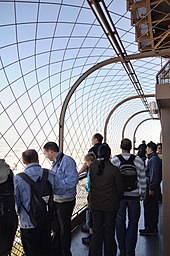
The top observation deck
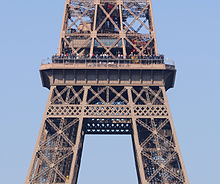
Second floor

Eiffel Tower seen from the Tour Montparnasse with the Champ de Mars and the École Militaire to the southeast

Detail of the arch construction
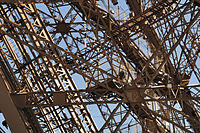
Longwall and stairs

North pillar from the interior view
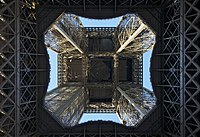
View from the middle to the top

Upper part from the second floor

View from the third floor vertically downwards
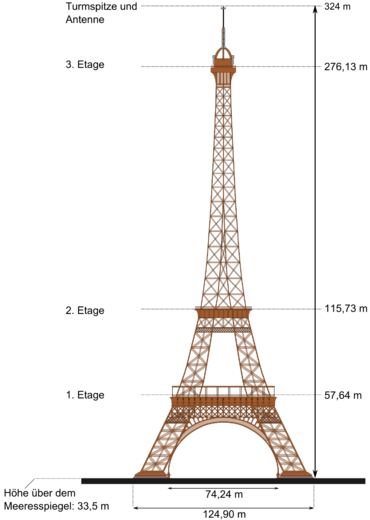
Schematic drawing of the Eiffel Tower with technical data

Third floor and spire
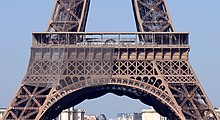
First floor
Facilities for the public
The Eiffel Tower is generally open to the public 365 days a year without a day off. Only during strong storms it can come to the closure or to restrictions. In total, more than 600 people are employed at or for the landmark. Among them are 280 administrative staff working for the SETE. About 240 are employed in the restaurant operations, 50 in souvenir sales, and 50 perform other jobs, mostly technical. There is a post office in the tower, and a police task force guards the monument. Due to the comparatively high income, the Eiffel Tower is one of the few French sights that manage without state subsidies.
Visitor numbers and statistics

In the year of its opening, almost 1.9 million of the total 32.3 million exhibition visitors climbed the Eiffel Tower during the 1889 World's Fair. In the following ten years, the number of visitors leveled off to an average of around 250,000. During the 1900 World's Fair, the Eiffel Tower recorded just over 1 million visitors, despite significantly more exhibition visitors (50.8 million). In the following years, numbers fell further below the level of the first ten years until the tower was closed to the public during World War I from 1915 to 1918. When it reopened in 1919, the number of annual visitors rose to just under 480,000, with two notable outliers in 1931 and 1937 for the Paris Colonial and World Trade Fairs respectively, each attracting over 800,000 visitors. Because of World War II, the Eiffel Tower was closed in 1940; it reopened in June 1946. By the early 1950s, some 1 million visitors were already coming; in the following decades, more and more came, including many foreign tourists. In the mid-2000s, more than 6.5 million people came; in both 2011 and 2014, the figure was just over 7 million. Turnover in 2011 reached 85.7 million euros. With the increased number of visitors, reaching around 35,000 on peak days, waiting times have at times risen to several hours; overcrowding has been feared. Including 2011, over 260 million people have been to the Eiffel Tower since it opened. On 28 September 2017, the 300 millionth visitor was counted.
| Visitor numbers of the Eiffel Tower from 1889 to 2017 | |||||||||||||
| Year | Visitors | Year | Visitors | Year | Visitors | Year | Visitors | Year | Visitors | Year | Visitors | Year | Visitors |
| 1889 | 1.968.287 | 1910 | 203.803 | 1931 | 822.550 | 1952 | 1.250.094 | 1973 | 2.914.814 | 1994 | 5.419.462 | 2015 | 6.917.000 |
| 1890 | 393.414 | 1911 | 204.168 | 1932 | 339.242 | 1953 | 1.204.371 | 1974 | 3.018.455 | 1995 | 5.212.677 | 2016 | 5.841.026 |
| 1891 | 335.829 | 1912 | 258.950 | 1933 | 363.720 | 1954 | 1.301.152 | 1975 | 3.045.573 | 1996 | 5.530.279 | 2017 | 6.207.303 |
| 1892 | 277.276 | 1913 | 261.337 | 1934 | 322.969 | 1955 | 1.435.192 | 1976 | 3.050.606 | 1997 | 5.719.773 | ||
| 1893 | 265.894 | 1914 | 152.725 | 1935 | 288.643 | 1956 | 1.476.400 | 1977 | 3.298.844 | 1998 | 6.051.603 | ||
| 1894 | 210.836 | 1915 | closed year-round | 1936 | 264.145 | 1957 | 1.632.647 | 1978 | 3.430.886 | 1999 | 6.368.534 | ||
| 1895 | 218.974 | 1916 | 1937 | 809.978 | 1958 | 1.591.005 | 1979 | 3.429.571 | 2000 | 6.315.324 | |||
| 1896 | 226.654 | 1917 | 1938 | 258.306 | 1959 | 1.668.558 | 1980 | 3.594.190 | 2001 | 6.103.987 | |||
| 1897 | 199.827 | 1918 | 1939 | 252.495 | 1960 | 1.735.230 | 1981 | 3.393.208 | 2002 | 6.157.042 | |||
| 1898 | 183.391 | 1919 | 311.714 | 1940 | closed all yearJune | 1961 | 1.763.448 | 1982 | 3.399.683 | 2003 | 5.864.969 | ||
| 1899 | 149.580 | 1920 | 417.869 | 1941 | 1962 | 1.735.796 | 1983 | 3.701.558 | 2004 | 6.230.050 | |||
| 1900 | 1.024.887 | 1921 | 426.635 | 1942 | 1963 | 2.013.594 | 1984 | 4.183.857 | 2005 | 6.428.441 | |||
| 1901 | 131.724 | 1922 | 422.172 | 1943 | 1964 | 2.143.173 | 1985 | 4.368.573 | 2006 | 6.719.200 | |||
| 1902 | 121.144 | 1923 | 551.444 | 1944 | 1965 | 2.295.193 | 1986 | 4.386.291 | 2007 | 6.959.186 | |||
| 1903 | 122.979 | 1924 | 585.730 | 1945 | 1966 | 2.405.554 | 1987 | 4.293.187 | 2008 | 6.929.463 | |||
| 1904 | 156.918 | 1925 | 631.758 | 1946 | 603.349 | 1967 | 2.416.502 | 1988 | 4.668.468 | 2009 | 6.603.792 | ||
| 1905 | 169.770 | 1926 | 657.004 | 1947 | 1.009.161 | 1968 | 2.070.417 | 1989 | 5.580.363 | 2010 | 6.709.634 | ||
| 1906 | 182.399 | 1927 | 555.087 | 1948 | 958.386 | 1969 | 2.561.157 | 1990 | 5.698.613 | 2011 | 7.086.273 | ||
| 1907 | 190.026 | 1928 | 634.819 | 1949 | 1.143.046 | 1970 | 2.757.768 | 1991 | 5.442.346 | 2012 | 6.270.000 | ||
| 1908 | 189.338 | 1929 | 577.624 | 1950 | 1.026.631 | 1971 | 2.899.070 | 1992 | 5.747.357 | 2013 | 6.740.000 | ||
| 1909 | 181.574 | 1930 | 580.075 | 1951 | 1.129.637 | 1972 | 3.003.659 | 1993 | 5.537.155 | 2014 | 7.097.302 | ||
| Number of visitors to the Eiffel Tower from 1889 to 2017 (cumulative) | |||||||||||||
| Year | Visitors | Year | Visitors | Year | Visitors | Year | Visitors | Year | Visitors | Year | Visitors | Year | Visitors |
| 1889 | 1.968.287 | 1910 | 7.104.524 | 1931 | 15.156.185 | 1952 | 25.175.987 | 1973 | 68.200.687 | 1994 | 156.888.933 | 2015 | 290.903.462 |
| 1890 | 2.361.701 | 1911 | 7.308.692 | 1932 | 15.495.427 | 1953 | 26.380.358 | 1974 | 71.219.142 | 1995 | 162.101.610 | 2016 | 296.744.488 |
| 1891 | 2.697.530 | 1912 | 7.567.642 | 1933 | 15.859.147 | 1954 | 27.681.510 | 1975 | 74.264.715 | 1996 | 167.631.889 | 2017 | 302.951.791 |
| 1892 | 2.974.806 | 1913 | 7.828.979 | 1934 | 16.182.116 | 1955 | 29.116.702 | 1976 | 77.315.321 | 1997 | 173.351.662 | ||
| 1893 | 3.240.700 | 1914 | 7.981.704 | 1935 | 16.470.759 | 1956 | 30.593.102 | 1977 | 80.614.165 | 1998 | 179.403.265 | ||
| 1894 | 3.451.536 | 1915 | 7.981.704 | 1936 | 16.734.904 | 1957 | 32.225.749 | 1978 | 84.045.051 | 1999 | 185.771.799 | ||
| 1895 | 3.670.510 | 1916 | 7.981.704 | 1937 | 17.544.882 | 1958 | 33.816.754 | 1979 | 87.474.622 | 2000 | 192.087.123 | ||
| 1896 | 3.897.164 | 1917 | 7.981.704 | 1938 | 17.803.188 | 1959 | 35.485.312 | 1980 | 91.068.812 | 2001 | 198.191.110 | ||
| 1897 | 4.096.991 | 1918 | 7.981.704 | 1939 | 18.055.683 | 1960 | 37.220.542 | 1981 | 94.462.020 | 2002 | 204.348.152 | ||
| 1898 | 4.280.382 | 1919 | 8.293.418 | 1940 | 18.055.683 | 1961 | 38.983.990 | 1982 | 97.861.703 | 2003 | 210.213.121 | ||
| 1899 | 4.429.962 | 1920 | 8.711.287 | 1941 | 18.055.683 | 1962 | 40.719.786 | 1983 | 101.563.261 | 2004 | 216.443.171 | ||
| 1900 | 5.454.849 | 1921 | 9.137.922 | 1942 | 18.055.683 | 1963 | 42.733.380 | 1984 | 105.747.118 | 2005 | 222.871.612 | ||
| 1901 | 5.586.573 | 1922 | 9.560.094 | 1943 | 18.055.683 | 1964 | 44.876.553 | 1985 | 110.115.691 | 2006 | 229.590.812 | ||
| 1902 | 5.707.717 | 1923 | 10.111.538 | 1944 | 18.055.683 | 1965 | 47.171.746 | 1986 | 114.501.982 | 2007 | 236.549.998 | ||
| 1903 | 5.830.696 | 1924 | 10.697.268 | 1945 | 18.055.683 | 1966 | 49.577.300 | 1987 | 118.795.169 | 2008 | 243.479.461 | ||
| 1904 | 5.987.614 | 1925 | 11.329.026 | 1946 | 18.659.032 | 1967 | 51.993.802 | 1988 | 123.463.637 | 2009 | 250.083.253 | ||
| 1905 | 6.157.384 | 1926 | 11.986.030 | 1947 | 19.668.193 | 1968 | 54.064.219 | 1989 | 129.044.000 | 2010 | 256.792.887 | ||
| 1906 | 6.339.783 | 1927 | 12.541.117 | 1948 | 20.626.579 | 1969 | 56.625.376 | 1990 | 134.742.613 | 2011 | 263.879.160 | ||
| 1907 | 6.529.809 | 1928 | 13.175.936 | 1949 | 21.769.625 | 1970 | 59.383.144 | 1991 | 140.184.959 | 2012 | 270.149.160 | ||
| 1908 | 6.719.147 | 1929 | 13.753.560 | 1950 | 22.796.256 | 1971 | 62.282.214 | 1992 | 145.932.316 | 2013 | 276.889.160 | ||
| 1909 | 6.900.721 | 1930 | 14.333.635 | 1951 | 23.925.893 | 1972 | 65.285.873 | 1993 | 151.469.471 | 2014 | 283.986.462 | ||
According to a statistical survey of 7,989 visitors, the profile in 2009 was as follows: the majority of visitors came from Western Europe (43%), metropolitanFrance (29%) and North America (11%). Apart from France, the strongest visitor countries were Germany with 8.5%, the United Kingdom with 8.1%, followed by the United States (7.6%), Spain (7.3%), Italy (4.8%) and Australia (4.1%). If we divide the age of visitors into the categories "under 25", from "26 to 35", from "36 to 45" and "over", they each take up around a quarter. Over 56 years were only 6.4%. The majority of visitors came with their family (63.8%); around 23% visit the Eiffel Tower with friends and 7.8% in organised tour groups. Just under half (46.1%) came by metro, 17.3% came on foot, 12% by their own car and 7.5% by bus. About 46% of respondents had been to the Eiffel Tower before.
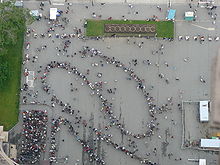
Queue at the Eiffel Tower
Search within the encyclopedia